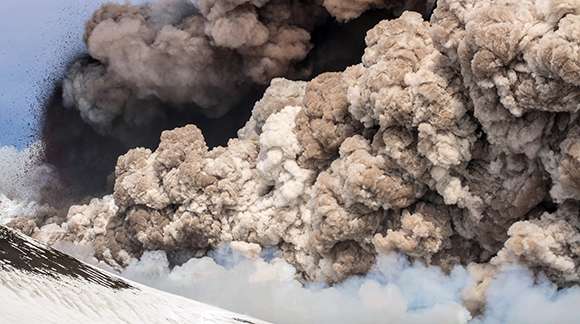
When tons of ash spewed into the atmosphere from a 2010 Icelandic volcano it caused havoc for vacationers across Europe. But did it also dramatically change clouds? Researchers at Pacific Northwest National Laboratory found that volcanic ash is not as efficient as common dust in birthing clouds’ ice particles. Using a novel laboratory testing chamber they formed cloud ice, a process called ice nucleation, around particles of dust and volcanic ash. Their results revealed the importance of optimal particle structure to efficiently attract super cold water vapor to nucleate ice.
“We described the detailed particle properties of ash, not currently included in atmospheric models,” said Dr. Gourihar Kulkarni, atmospheric scientist at PNNL and lead author of the study. “By including the missing information, we can increase model confidence in simulating the deposition mode of ice nucleation.”
Volcanic eruptions occur almost every day somewhere around the globe. These eruptions provide a constant source of fine ash injected into the part of the atmosphere where clouds are born. These particles can alter clouds but the process is not yet well understood. Researchers at PNNL are using novel techniques to simulate how ash particles compete with already existing natural particles such as dust to birth cloud ice. Because more than half the Earth’s precipitation comes from cloud ice particles, scientists are working to understand all the ways ice crystals are formed during ice nucleation. Including these fundamental discoveries about cloud formation in climate and weather forecast models will support new insight for precipitation and prediction of climate change.
PNNL scientists and a collaborator from the Qatar Environment and Energy Research Institute investigated the ice nucleating properties of ash particles from the 2010 Iceland volcanic eruption at Eyjafjallajökull (see sidebar, Cloud Ice Birthing, and the Icelandic Volcano with the Hard-to-Say Name). They used the ice nucleation chamber at PNNL’s Atmospheric Measurement Laboratory (AML) to test and compare how ash and dust particles nucleate ice in a super cold atmosphere.
At the same time, they applied bulk and single-particle techniques to analyze the surface elemental composition, morphology structural, and shape factor properties of volcanic ash particles at the U.S. Department of Energy’s Environmental Molecular Sciences Laboratory (EMSL) user facility. Researchers also examined the relative importance of ice nucleation behavior of these particles to proxy natural dust particles. These techniques provide detailed information at a molecular level to compare and understand the ice formation ability of ash and dust particles.
Detailed quantification of structural properties is necessary to develop the simplified equations, called parameterizations, used to describe heterogeneous (water to non-water particle) ice nucleation in climate models. Determining ice nucleation efficiencies of volcanic ash particles from different eruption periods will further explain the impact of volcanic particles on clouds. Understanding cloud condensation nucleation properties of these volcanic particles will advance the long-term goal to provide a fundamental theory basis representing the ice nucleation process in climate models.
Reference:
“Effects of Crystallographic Properties on the Ice Nucleation Properties of Volcanic Ash Particles.” Geophysical Research Letters 42. DOI: 10.1002/2015GL063270.
Note : The above story is based on materials provided by Pacific Northwest National Laboratory.









